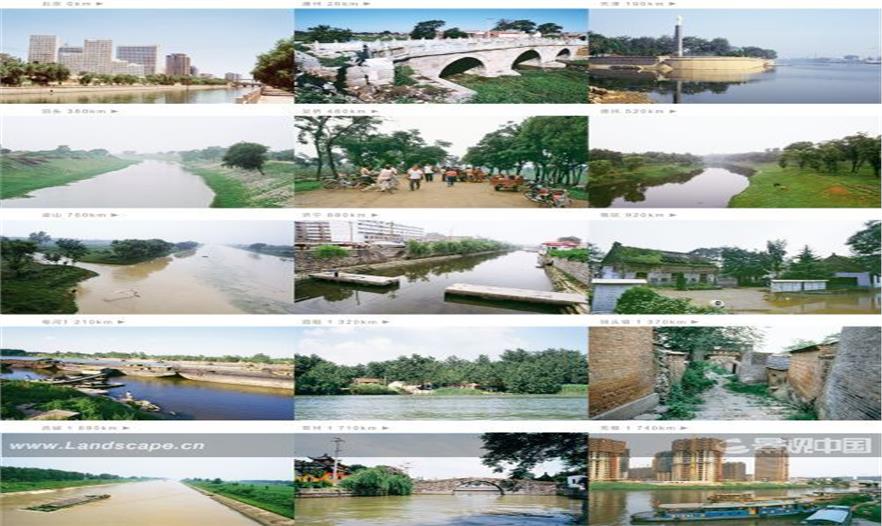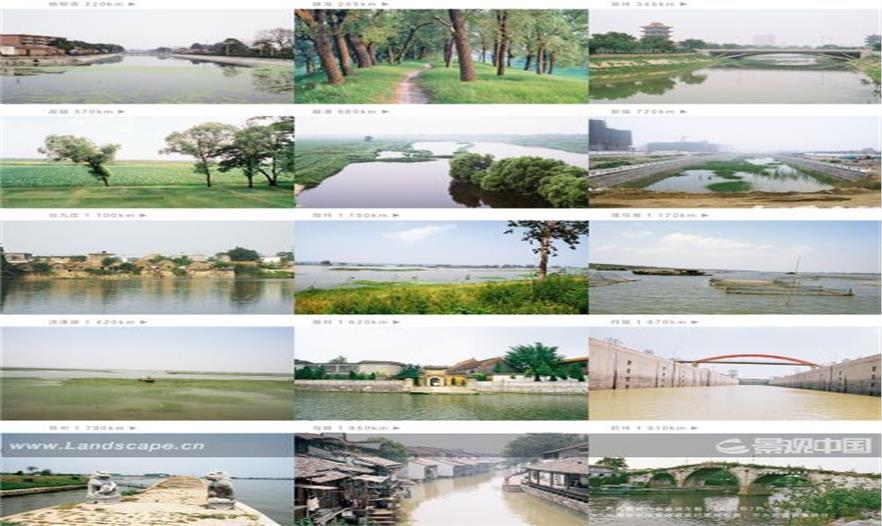世界文化遺產(chǎn)視野中的京杭大運(yùn)河的保護(hù)是無疑的:從技術(shù)或歷史的角度來看����,中國的大運(yùn)河具有作為世界文化遺產(chǎn)的突出普遍價(jià)值。


中國歷史教科書上的京杭大運(yùn)河是清楚的:世界上里程最長(zhǎng)的一條人工運(yùn)河�����,是蘇伊士運(yùn)河的16倍�、巴拿馬運(yùn)河的33倍,與長(zhǎng)城并稱為中國古代的兩項(xiàng)偉大工程��,開鑿至今已有近2 500年的歷史��。
中國地圖上的京杭大運(yùn)河是明確的:北起北京(涿郡)����,南到杭州(余杭),途經(jīng)北京�、天津二直轄市及河北、山東�����、江蘇、浙江四省���,貫通海河�、黃河����、淮河���、長(zhǎng)江��、錢塘江五大水系�����,全長(zhǎng)約1 794km�。
世界科技史上對(duì)京杭大運(yùn)河的高度評(píng)價(jià)是鮮明的:人類歷史上最古老的人工運(yùn)河���,在技術(shù)上和工程規(guī)模上�����,中國的大運(yùn)河都是無與倫比的。
世界文化遺產(chǎn)視野中的京杭大運(yùn)河的保護(hù)是無疑的:從技術(shù)或歷史的角度來看�,中國的大運(yùn)河具有作為世界文化遺產(chǎn)的突出普遍價(jià)值。
然而�,當(dāng)我們用當(dāng)代人的雙腳走近大運(yùn)河���,當(dāng)我們用當(dāng)代科學(xué)的視角去審視大運(yùn)河�,當(dāng)我們用當(dāng)代文化遺產(chǎn)的標(biāo)準(zhǔn)去評(píng)價(jià)大運(yùn)河時(shí)�����,我們突然發(fā)現(xiàn)��,這一看似時(shí)空分明��、價(jià)值確鑿的人類工程奇跡�,卻是如此的模糊不清,只能從文學(xué)作品和傳說中感知它的身影�。一位資深的聯(lián)合國教科文組織文化遺產(chǎn)專家想了解大運(yùn)河時(shí),卻發(fā)現(xiàn)在當(dāng)代科學(xué)的英文語境中�,甚至找不到一篇可以引用的關(guān)于大運(yùn)河的學(xué)術(shù)性論文。關(guān)于大運(yùn)河的一些基本問題擺在我們面前�����,諸如,如何定義京杭大運(yùn)河���,如何在坐標(biāo)系統(tǒng)準(zhǔn)確標(biāo)明京杭大運(yùn)河���,判別哪條河道屬于京杭大運(yùn)河,京杭大運(yùn)河有多寬����,邊界在哪里,哪些文物屬于京杭大運(yùn)河遺產(chǎn)��,都分布在哪��,有多少�,它的價(jià)值到底在哪�����,如何確認(rèn)它的價(jià)值���,該如何保護(hù)……原來�����,作為中國大地上最為重要的文化景觀�,大運(yùn)河在很大程度上是文學(xué)的,甚至是傳說的�����?�?茖W(xué)視野及當(dāng)代文化遺產(chǎn)保護(hù)視野中的京杭大運(yùn)河是模糊不清的�����,需要我們?nèi)ふ摇?
正是在這樣的背景下����,北京大學(xué)景觀設(shè)計(jì)學(xué)研究院經(jīng)過多年的預(yù)研究后,于2003年申請(qǐng)全國文物保護(hù)科學(xué)研究課題“中國京杭大運(yùn)河整體保護(hù)研究”項(xiàng)目���,并獲得國家文物局的支持��,正式開啟科學(xué)尋找大運(yùn)河的歷程���。這一研究包括歷時(shí)30天、師生全程騎車考查大運(yùn)河及沿線,以及此后延續(xù)近10年的重點(diǎn)河段的實(shí)證考查和保護(hù)規(guī)劃研究����。10年研究成果除了發(fā)表大量論文并協(xié)助國家文物局編制重要河段的保護(hù)規(guī)劃外,還培養(yǎng)了40多位以大運(yùn)河為研究課題的碩士及博士研究生�����。課題組對(duì)一些最基本而又最重要的問題進(jìn)行了探討����,包括:
大運(yùn)河在當(dāng)代的存在狀態(tài):通過包括對(duì)大運(yùn)河全程的實(shí)地考查,并用圖像和文字記錄����,以及實(shí)測(cè)100多個(gè)不同的河道斷面來解剖定格于2004年的大運(yùn)河生存狀態(tài),它作為未來研究大運(yùn)河的一個(gè)基本物理參照����。同時(shí),收錄匯總了沿運(yùn)文化遺產(chǎn)點(diǎn)���,并部分考查驗(yàn)證。通過對(duì)生存狀態(tài)的研究發(fā)現(xiàn):大運(yùn)河這樣一條對(duì)國土生態(tài)安全和民族文化認(rèn)同具有關(guān)鍵意義的遺產(chǎn)與生態(tài)廊道��,目前面臨著嚴(yán)重的威脅,如不盡快統(tǒng)一規(guī)劃��、保護(hù)�、管理和建設(shè),必將成為難以挽回的遺憾�。運(yùn)河及沿線的許多珍貴遺產(chǎn)正在消失和遭受破壞,部分古運(yùn)河河道地段已被開墾耕種����,有的已成為垃圾坑和排污溝,一些世界級(jí)的水工設(shè)施已遭嚴(yán)重毀壞�;以運(yùn)河為骨架的水系統(tǒng)和濕地系統(tǒng)正面臨惡化,千百年的人工和自然過程使大運(yùn)河與區(qū)域水系統(tǒng)形成了一個(gè)連續(xù)的�、完整的、富有生命的生態(tài)景觀網(wǎng)絡(luò)����,而在近些年的城市建設(shè)、市政基礎(chǔ)設(shè)施建設(shè)和水利工程建設(shè)等過程中��,這一生態(tài)景觀網(wǎng)絡(luò)已受到嚴(yán)重破壞�,包括污染、截?cái)?���、河道硬化渠化�����、水系填埋和覆蓋�,如不進(jìn)行系統(tǒng)的規(guī)劃和管理�,大運(yùn)河雖有形骸卻無生命;城市擴(kuò)張和急功近利的工程正在吞嚙國家遺產(chǎn)����,許多地方?jīng)]有真正認(rèn)識(shí)到大運(yùn)河的生態(tài)與遺產(chǎn)價(jià)值,而是片面追求眼前利益��,開展各類破壞性的工程建設(shè)��,包括夾運(yùn)房地產(chǎn)開發(fā)���、粗制濫造假古董開發(fā)旅游等�,嚴(yán)重?fù)p害了大運(yùn)河遺產(chǎn)廊道的真實(shí)性�����,導(dǎo)致生態(tài)服務(wù)功能喪失���;南水北調(diào)工程的歷史機(jī)遇和挑戰(zhàn)����,是繼京杭大運(yùn)河開鑿以來對(duì)以運(yùn)河為主體形成的區(qū)域生態(tài)網(wǎng)絡(luò)施加的又一次人工干擾�����,這是對(duì)運(yùn)河遺產(chǎn)廊道保護(hù)的一次挑戰(zhàn)�,同時(shí)也是一次歷史性機(jī)遇,如果明智地規(guī)劃利用��,會(huì)有利于運(yùn)河斷流和生態(tài)功能癱瘓區(qū)域系統(tǒng)的生態(tài)系統(tǒng)修復(fù)及運(yùn)河遺產(chǎn)保護(hù)���,從而實(shí)現(xiàn)生態(tài)與遺產(chǎn)廊道的建立�。
大運(yùn)河的完全價(jià)值觀:從歷史��、當(dāng)代與未來的視角出發(fā)�,提出大運(yùn)河的完全價(jià)值觀,認(rèn)為其具有四大基本價(jià)值:作為文化遺產(chǎn)的價(jià)值�����,起到彰顯民族身份和促進(jìn)文化認(rèn)同的作用����;作為區(qū)域城鄉(xiāng)生產(chǎn)與生活的重要保障���,具有輸水、航運(yùn)和灌溉等現(xiàn)實(shí)功用的價(jià)值����;作為區(qū)域生態(tài)基礎(chǔ)設(shè)施的價(jià)值,是保障國土生態(tài)安全的關(guān)鍵性格局���;運(yùn)河還具有作為潛在的休閑通道的價(jià)值�����,是國民身心再生和教育的戰(zhàn)略性資源����。只有用完全的價(jià)值觀充分認(rèn)識(shí)運(yùn)河廊道����,并處理好現(xiàn)實(shí)的功能需要以及這些價(jià)值間的相互關(guān)系,才能保護(hù)和利用好運(yùn)河遺產(chǎn)及其相關(guān)資源���,使之在當(dāng)代發(fā)揮應(yīng)有的作用�。在此基礎(chǔ)上提出以建設(shè)遺產(chǎn)廊道的方式��、結(jié)合南水北調(diào)工程和東部生態(tài)安全格局及中國南北生態(tài)休閑廊道的建設(shè),將保護(hù)與利用京杭大運(yùn)河作為國家戰(zhàn)略��。任何單一的價(jià)值觀(如從單一的輸水功能考慮)和單一的工程措施����,都將給中國大地上這一獨(dú)特的文化景觀和與之相聯(lián)系的歷史文化��、生態(tài)及社會(huì)經(jīng)濟(jì)系統(tǒng)帶來不可挽回的遺憾����。
用“國家遺產(chǎn)與生態(tài)廊道”概念界定大運(yùn)河:通過對(duì)歷史過程的梳理,闡釋運(yùn)河在各歷史時(shí)期演變進(jìn)程中構(gòu)成要素的功能與相互關(guān)系����,是科學(xué)界定大運(yùn)河遺產(chǎn)廊道構(gòu)成的重要途徑。大運(yùn)河遺產(chǎn)廊道由自然生態(tài)系統(tǒng)����、文化遺產(chǎn)系統(tǒng)與廊道支持系統(tǒng)三大部分構(gòu)成:作為大運(yùn)河發(fā)生背景,與大運(yùn)河生態(tài)功能維護(hù)相關(guān)的濕地����、林地、農(nóng)田等區(qū)域景觀和環(huán)境要素構(gòu)成大運(yùn)河廊道重要的自然生態(tài)系統(tǒng)����;與大運(yùn)河“漕運(yùn)”功能相關(guān)的河道��、水源����、水利與航運(yùn)工程設(shè)施等水利工程遺產(chǎn)��,與歷史相關(guān)的古建筑����、古遺址、運(yùn)河聚落等運(yùn)河相關(guān)物質(zhì)文化遺產(chǎn)及戲曲歌舞�、民俗傳說等非物質(zhì)文化遺產(chǎn),與空間相關(guān)的其他非運(yùn)河類物質(zhì)與非物質(zhì)文化遺產(chǎn)構(gòu)成廊道重要的文化遺產(chǎn)系統(tǒng)��;游憩道�����、解說系統(tǒng)�����、公共服務(wù)設(shè)施構(gòu)成廊道重要的支持系統(tǒng)。這三者是沿運(yùn)地區(qū)可持續(xù)發(fā)展所不可或缺的基礎(chǔ)性自然資產(chǎn)���、文化資產(chǎn)和社會(huì)資產(chǎn)�。整合構(gòu)成集生態(tài)與遺產(chǎn)保護(hù)�、休閑游憩、審美啟智與教育為一體的大運(yùn)河遺產(chǎn)廊道�����。
大運(yùn)河保護(hù)的方法論:建立國家文化遺產(chǎn)與生態(tài)廊道���,作為中國生態(tài)基礎(chǔ)設(shè)施的核心骨架來保護(hù)和利用大運(yùn)河,是大運(yùn)河保護(hù)的基本方法論�。生態(tài)基礎(chǔ)設(shè)施是城市所依賴的自然系統(tǒng),是城市及其居民能持續(xù)地獲得自然服務(wù)的基礎(chǔ)�����,它不僅包括傳統(tǒng)的城市綠地系統(tǒng)的概念�,而是更廣泛地包含一切能提供自然服務(wù)的城市綠地系統(tǒng)、森林生態(tài)系統(tǒng)�����、農(nóng)田系統(tǒng)及自然保護(hù)地系統(tǒng)。如同城市的市政基礎(chǔ)設(shè)施一樣����,區(qū)域和城市的生態(tài)基礎(chǔ)設(shè)施需要有前瞻性,更需要突破城市規(guī)劃的既定邊界�����。以京杭大運(yùn)河為骨架和主體形成的��,包括支流和湖泊��、池塘�����、沼澤等濕地在內(nèi)的運(yùn)河區(qū)域生態(tài)網(wǎng)絡(luò)長(zhǎng)期參與和影響河域的生態(tài)演化進(jìn)程�����,已經(jīng)成為區(qū)域生態(tài)的重要組成部分����,具有重要的景觀生態(tài)學(xué)及區(qū)域生態(tài)戰(zhàn)略意義。在經(jīng)濟(jì)高速增長(zhǎng)��、快速城市化和南水北調(diào)工程建設(shè)背景下,這一生態(tài)網(wǎng)絡(luò)面臨著巨大的挑戰(zhàn)和廣闊的機(jī)遇�����。在這樣巨大的機(jī)遇和挑戰(zhàn)面前����,建立大運(yùn)河區(qū)域生態(tài)基礎(chǔ)設(shè)施,對(duì)中國東部廣大地區(qū)獲得健康的生態(tài)服務(wù)���、對(duì)中國東部城市帶的可持續(xù)發(fā)展��、對(duì)遺產(chǎn)廊道本身的保護(hù)以及未來居民的休閑和教育需求的提供,都具有非常重要的戰(zhàn)略意義��。
這些研究只是初步的���、基礎(chǔ)性的��,更深入和廣泛的科學(xué)研究亟待開展�����?�?梢钥隙ǖ氖?�,以當(dāng)代科學(xué)和文化遺產(chǎn)保護(hù)視野來認(rèn)識(shí)大運(yùn)河���,必將為我們展現(xiàn)出真實(shí)而完整的大運(yùn)河的世界獨(dú)一無二魅力���。
在進(jìn)行科學(xué)研究的同時(shí),一系列旨在保護(hù)與恢復(fù)大運(yùn)河的景觀工程也在興起��。與單純的研究相比����,這些景觀工程成為中國社會(huì)、經(jīng)濟(jì)和政治的力量角逐的焦點(diǎn):對(duì)于唯利是圖的開發(fā)商來說�����,運(yùn)河邊的房子是個(gè)時(shí)尚的賣點(diǎn)����,運(yùn)河文化可以被免費(fèi)而高雅地消費(fèi),趨之如騖�;對(duì)于地方領(lǐng)導(dǎo)而言,運(yùn)河景觀廊道是叫得響的政績(jī)����,既可以創(chuàng)造GDP����,也可以獲得廣泛的民心�,何樂而不為;而對(duì)于國家和人民來說�,大運(yùn)河遺產(chǎn)廊道的建立是歷史記憶的修復(fù),關(guān)乎民族認(rèn)同和國家身份�。在這些力量的角逐中,景觀設(shè)計(jì)師被推到了大運(yùn)河保護(hù)與修復(fù)的前臺(tái)��。如何在真實(shí)性與完整性的遺產(chǎn)保護(hù)與恢復(fù)原則下���,創(chuàng)造性地重現(xiàn)大運(yùn)河景觀風(fēng)采���,并賦予其當(dāng)代的經(jīng)濟(jì)�����、社會(huì)�、生態(tài)和文化意義,是一項(xiàng)極富有挑戰(zhàn)的任務(wù)��。因此,功兮過兮��,對(duì)縱跨中國東部的大運(yùn)河的保護(hù)與修復(fù)��,是中國景觀設(shè)計(jì)學(xué)和景觀設(shè)計(jì)行業(yè)難以推脫的一份責(zé)任�。(蔡金棟 譯,陳凱兒 校)
From Chinese history textbooks, the importance of the Beijing-Hangzhou Grand Canal is clear: it is the world’s longest canal — it is 16 times the length of the Suez Canal and 33 times that of Panama Canal. It rivals the Great Wall as one of the two greatest man-made wonders in ancient China; it has a history of almost 2,500 years.
The 1,794-kilometer Beijing-Hangzhou Grand Canal is also clear on the map of China: starting from Beijing (known as Zhuojun in ancient times) and ending in Hangzhou (Yuhang), the canal runs through two major cities, Beijing and Tianjin, as well as four provinces, namely, Hebei, Shandong, Jiangsu and Zhejiang, and also connecting five major river systems of Haihe, Yellow, Huaihe, Yangtze and Qiantang.
According to history of the world’s science and technology, the importance of the Beijing-Hangzhou Grand Canal is also clear: being the oldest canal in human history, China’s Beijing-Hangzhou Grand Canal is exceptional in terms of its pioneering technology and engineering scale.
There is no doubt that the protection of the Grand Canal is paramount: because of its universal value as world cultural heritage from the technical and historical perspective.
However, when we now in fact walk close to the Grand Canal, when we now look at it through modern, scientific eyes and evaluate it with the standards of modern cultural heritage, we suddenly find it in a time warp. This engineering marvel, which is so clear and evidently of value, is now so blurred. We can just trace it from literature and folklore. When a respected UNESCO world cultural heritage specialist tried to know more about the Grand Canal, he could not even find a citable, modern sciences academic paper in the English. Even the basic information regarding the canal was unclear. Questions, such as the definition of the Grand Canal, its positions in the coordinate system, the identification of its river channels, its width and boundary, its historical relics, their distributions, quantities, values, the way to identify their values, and the way to protect them, etc., which are right in front of us. It turns out the Grand Canal, the most important cultural landscape on the Chinese territory, exists largely as a literary or even mythical motif. While in the realm of sciences, or in the field of modern cultural heritage protection, the Grand Canal is very vague, indicating that there is much work to be done.
Given this, after years of pre-study, the Graduate School of Landscape Architecture of Peking University decided to apply in 2003 for a research grant, as one of the national research projects for the protection of China’s cultural heritage, with the research project titled: the Overall Protection of China’s Beijing-Hangzhou Grand Canal. The support from the State Administration of Cultural Heritage kicked off the analysis process of the Grand Canal. It took the professors and students 30 days to carry out a whole-course on-site survey on bicycles, and following which, nearly 10 years to conduct field investigations on key places and research on protection and planning. During these 10 years, besides having published a large number of papers and helping the State Administration of Cultural Heritage to formulate the protective planning for key places, they trained more than 40 masters and doctoral students who are devoted to the research of the Grand Canal. The work examined the most fundamental yet extremely important issues, which include:
The existing conditions of the contemporary Grand Canal: with the field survey of the whole canal, images and texts, and more than 100 cross-sections of the canal, the ecological conditions of the canal are frozen in 2004 to serve as a fundamental physical reference for future research. At the same time, spots of cultural heritage along the canal were partly collected and examined. Research of its ecological conditions indicate that, the Grand Canal, the heritage and ecological corridor that is of such importance in terms of national ecological security and cultural identity, faces grave challenges. Without timely and unified planning, protection, management and construction, regrets will be inevitable. Many precious heritages on and along the canal are disappearing or being destroyed, some parts of the canal has been reclaimed for farmland, some other parts have been turned into dump pits and pollution discharge ditches. Some world-class hydraulic structures have been severely damaged. The water and wetland systems that rely on the framework of the Grand Canal are facing degradation. In the past centuries, the artificial and natural processes had turned the canal into a continuous, holistic and living ecological landscape network. However, such network has been seriously damaged by urban development, municipal infrastructure building and the construction of hydraulic projects in recent years in the forms of pollution, cutting off, hardening and channelization, as well as landfill and covering of water systems. Without systematic planning and management, the soul of the Grand Canal will be taken away, leaving only the carcass behind. National heritage is being swallowed by urban expansion and projects eagering for quick benefits. In many places, the ecological and heritage value of the canal is not really understood, and in the pursuit of quick profits, damaging projects are allowed to proceed such as housing development and replicated objects are fabricated for tourist purposes. All this reduces the authenticity of the canal as a heritage corridor, as well as leading to a loss of its ecological service functions. The launch of the South-to-North Water Diversion Project brings both opportunity and challenge. It will be another human interference in the regional ecological network that takes the Grand Canal as the framework and main body, which could be a threat to the protection of the heritage corridor. At the same time, it could also be a historic opportunity that will, if wisely planned and utilized, be helpful for the ecological restoration for the cut-off sections and ecologically paralyzed areas of the canal, heritage protection, and the establishment of the ecological and heritage corridor.
The value of the Grand Canal in its entirety: the value of the Grand Canal in its entirety considers it from the perspective of its past, present and future. Four basic values have been identified: the value of cultural heritage in highlighting national identity and promoting cultural recognition; the practical value of water diversion, navigation and irrigation that makes the canal important safeguard for regional urban and rural productions and lives; the value of potential recreation belt that is also an important strategic resource for national physical and psychological regeneration and education. Only when the canal corridor is fully understood in this complete sense, and only when the interactive relationship between practical functions and these values are well handled, can the canal heritage and related resources be well protected and utilized, and the roles of the canal be well played in modern times. Based on this complete vision, the protection and utilization of the canal as a national strategy is proposed to take the form of building heritage corridor and combine the South-to-North Water Diversion Project, the ecological safety layout of east China and the construction of south-north ecological recreation corridor in China. Any single-purpose project (such as the single consideration of water diversion function) or single engineering measures will cause irrecoverable damage upon such unique cultural landscape on the Chinese territory, as well as the related historical culture, ecology and socio-economic system.
Definition of the Grand Canal using the concept of national heritage and ecological corridor: it is the important means of scientifically defining the heritage corridor of the Grand Canal by examining the historical processes and explaining the roles of function and interrelation the canal has played throughout the historical phases. The heritage corridor of the Grand Canal consists of natural ecosystem, cultural heritage system and corridor supporting system. The important natural ecosystem constitutes wetlands, woodlands, farmlands and other regional landscape and environmental elements that are related to the maintenance of the canal’s ecological functions and serve as the surrounding environment of the canal. The important cultural heritage system constitutes the river channels, water sources, water conservancy projects and navigation facilities that are serve the waterway transportation function, tangible cultural heritage items such as historical buildings, relics and settlements along the canal, intangible cultural heritage such as dramas, songs, dances, customs and folktales. The other system that is important to the canal, though may not be directly related to the canal but are spatially linked includes things such as leisure walkways, explanation system and public service facilities. These three systems are the fundamental to the natural, cultural and social assets, and are indispensable for the sustainable development of the region along the canal. The heritage corridor of the Grand Canal should not developed without integrating ecological and heritage protection, recreation and rest, beauty appreciation, enlightenment and education.
Methodology for protecting the Grand Canal: the fundamental methodology for protecting the canal is to establish a national cultural heritage and ecological corridor and to protect and utilize the canal as the core framework of the ecological infrastructure in China. Ecological infrastructure is the natural system which cities rely on, and the basis for cities and their residents to continuously receive natural services. It includes not only the conventional concept of urban green space system, but also the forest ecosystem, farmland system and natural reserve system that also provide natural services. Like the municipal infrastructure in cities, foresight is needed for the ecological infrastructure in regional and urban areas to break off the existing boundaries defined by the urban planning. The regional ecological network, which takes the Grand Canal as its framework as well as its main body, including its tributaries, lakes, ponds, swamps and wetlands, has long been engaged in and influencing the ecological evolution process of the river areas. It has become an important part of the regional ecology, and possesses significant importance of landscape ecology and regional ecological strategy. With fast economic growth, rapid urbanization and the construction of the South-to-North Water Diversion Project, such ecological network faces enormous challenges as well as immense opportunities. Facing the huge opportunities and challenges, the construction of ecological infrastructure in the area of the Grand Canal will have a significant and strategic importance for securing healthy ecological services in the vast land of east China, the sustainable development of the city belt in east China, the protection of the heritage corridor itself, whilst fulfilling the recreational and educational demands of future residents.
This research is only just beginning, but they are essential. More in-depth and extensive scientific research is needed. What can be sure is that, when we look at the Grand Canal from the perspectives of modern science and cultural heritage protection, we see a canal that is unique in the world, true and complete.
While scientific research is being conducted, a series of landscape projects are also emerging to protect and restore the Grand Canal. Compared to research, these landscape projects will become sites of contest for China’s social, economic and political forces. For greedy developers, houses along the canal will be a fashionable selling point, and the canal culture can be elegantly and freely consumed and pursued. For the local governments, canal landscape corridor will be their remarkable political achievements, such projects can generate huge GDP, and are supported by the public. And for the country and the people, the establishment of the heritage corridor of the Grand Canal means the repair of historical memories, enhancing national identity. In the competition of these forces, landscape architects are pushed to the foreground in protecting and restoring the Grand Canal. It will be extremely challenging to, while sticking to the principle of heritage protection and restoration that focuses on authenticity and completeness, creatively restore the landscape splendor of the canal and reflect the modern economic, social, ecological and cultural significance. Therefore, whether success or failure, it is the unshakable responsibility of the science and industry of landscape architecture in China to protect and restore the Grand Canal that stretches throughout the eastern part of the country. (Translated by Jindong CAI, Proofread by Anna CHAN)
原文出處:俞孔堅(jiān)�����,《景觀設(shè)計(jì)學(xué)》2012年第3期����,大運(yùn)河保護(hù)與再生,24-27
Source: Kongjian YU, Conversation and Recovery of the Grand Canal, Landscape Architecture Frontiers, 24-27

 京公海網(wǎng)安備 110108000058號(hào)
京公海網(wǎng)安備 110108000058號(hào)









